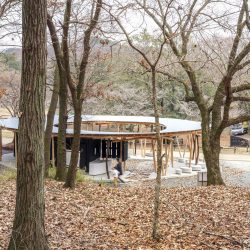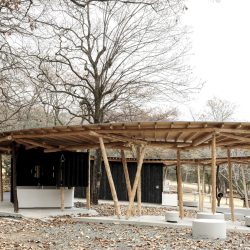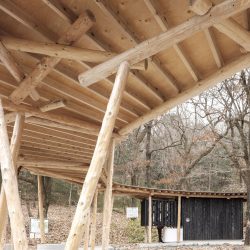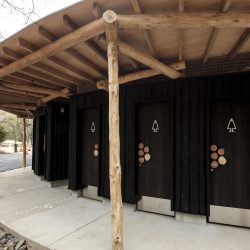
Yamashita Sekkei . photos: © yashiro photo office . + archdaily
Connecting people and nature through log architecture. In planning a public toilet to be built in a park called ‘Tatsudayama Rest Forest’, which has been loved by many people as a ‘forest in the city’, we wished to create architecture in harmony with the rich nature and to contribute to Kumamoto Prefecture, where the forestry industry is very active. While great expectations are focused on timber for the decarbonized society, the price of domestic timber continues to stagnate and the forestry industry is exhausted. By using logs as building materials, we tried to re-evaluate the value of wood, as almost 100% of the natural trees can be utilized.
Logs have been used as building materials since prehistoric times, but since the modern age, the standardization and commercialization of wood have progressed due to the need to verify safety calculations and the rationality of construction. As a result, greater loss rates and greater environmental impact during sawing have been incurred. Using modern analysis and processing techniques, the team explored ways to utilize logs of individually different lengths, thicknesses, and shapes, which are not available in the retail market. The facility is located at the intersection of nature and human activities, such as forests, lawn areas, walkways, and car parks.
Based on a circular sheltered space accessible from all directions, toilet booths, rest areas, and washrooms are arranged under the roof to suit the adjacent environment, creating a place to experience nature in the Tatsuda Mountains. The reciprocal structure of the frame, combining logs that have only been stripped of their bark from logs with individual, unique expressions, deepens the relationship between the architecture and nature. With the aim of using up the wood without any waste, the project used thin logs with a diameter of about 100 mm and the tips of the trees, which are usually under-utilized parts that are turned into chips. In addition, the scraps of sawn timber are used for wall timber. Furthermore, burnt cedar, a traditional local material, was produced and used as an external wall covering.
The majority of the timber is made in Kumamoto Prefecture and all wood drying, processing, and preservation treatment are completed in Kumamoto Prefecture, thereby making the most of local resources. Kumamoto is a region with a deeply rooted culture of handling wood, and the deep interest in wood, knowledge, and skills of the people involved helped to make this building a reality. We hope that the ‘circle of forests and people’ in Kumamoto will continue and expand in the future.
_





















